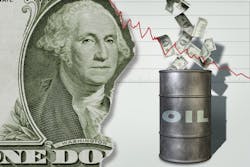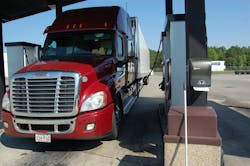Oil prices and freight rates: What to watch
The price of oil, and the corresponding price of fuel and transportation, is a function of the global economy and production fundamentals. The combination has driven oil prices down more than 60% over the past two years—but that decline will reverse. The questions are when, and then how rapidly? And what will it mean for trucking?
“All everybody can say right now is oil prices are low,” said FTR economist Noël Perry during a session on fuel pricing and transportation, part of the recent FTR Virtual Conference. “But oil fundamentals—the things that drive this market in the long term, or even in the medium term—have a very substantial upside case.”
Perry attributed the price decline to an abundant supply, including additional production from a recovering oil industry in Iraq and, most immediately, to the 500,000 barrels per day coming into the market as the sanctions against Iran are lifted.
The “caveat” in looking ahead, Perry explained, is that oil traders have a very pessimistic view of the world economy, compared to the consensus view of economists who anticipate some stability. But, if the traders are correct, falling demand will lead to falling prices comparable to 2009.
“So if the economy drops and we get recession, then oil prices will be low until the end of that recession,” Perry said. “But, assuming that doesn’t happen—which is what most economists are saying right now—then it falls back to fundamentals.”
But as oil prices began to fall in mid1-2014, diesel pricing lagged, which Perry attributed to likely supply chain issues. However, by the end of the year diesel was falling rapidly and had caught up by the first quarter of 2015.
Since then, the price of diesel has been below the basic cost relative to crude.
“So when, finally, the price of oil bottoms and starts moving up again—and this is the fundamental we’re worried about—the price of diesel will move up more rapidly,” Perry said, and again he noted such an increase is not a near-term concern. “But when it turns, people are going to be surprised because diesel will turn more.”
As to the market fundamentals, the basic crude oil supply from the Middle East “comes out of the ground” at a cost of around $20/barrel, and that supply is stable, Perry explained.
The cost to tap the crude supply in the U.S. runs between $40 and $70, the Canadian tar sands about $75, deep offshore wells about $80, and the cost to extract crude from the Arctic runs at $90. Those supplies only come on line when profitable. And, since the development of fracking technology, drilling in the U.S. has become “very responsive to price,” Perry continued.
Once oil pricing rebounds, Perry anticipates a surge to around $80 per barrel—bringing U.S. wells back on line—after which the price will settle at around $60.
“It’s not enough to kill intermodal, but it’s enough to take the bloom off,” Perry said. “Intermodal growth is not nearly what it was, and part of the issue is fuel.”
Indeed, falling fuel surcharges (FSC) have had a “dramatic” effect on rail intermodal pricing, added Larry Gross, FTR’s intermodal and rail expert.
“Overall growth in the base rate has slowed to a crawl somewhere in the 2% range because of the pressure we’re seeing from the over-the-road side,” Gross said. “Growth in intermodal is still going to occur, but they’re going to gain it the old-fashioned way by earning it, as opposed to just answering the phone and having market forces drive volume to the rails.”
Spot market pricing
The cost of diesel is also a significant factor in spot market freight pricing, although the ongoing downturn in spot pricing is not all about the fall in fuel, explained FTR Chief Operating Officer Jonathan Starks.
Using data from the load boards at Truckstop.com, Starks showed that broker posted rates have declined steadily since mid-2014—timing that corresponds both with the fall in the diesel price and with the freight market “normalizing” after record load availability and extremely tight capacity.
To start this year, market demand is running just below the 5-year average, and demand is down 33% from a year ago.
“But you compare it to 2014, it’s down nearly 60%—so it’s a pretty drastic decline,” Starks said.
And rates have turned decidedly lower to begin 2016, down 15% from a year ago and about 8% below the 5-year average. Fuel surcharges, as part of the broker rate, have played a role: FSC is down 45% from last year—and 2015 was down another 40% from the year before that.
“The fuel surcharge environment is very, very low compared to where we were just a year-and-half ago,” Starks said, noting that fuel pricing had been stable for about three years before the decline began. “We expect that we’re near the trough in FSC; it’s tough to see it going much lower than it is right now.”
But what’s lost in the basic rate data is that the spot market rates, with the FSC removed, are down only about 10% from 2015—and that’s 10% above the 5-year average, Starks explained.
“Freight demand has softened, and carrier pricing is hurting—but it’s not as bad as the overall numbers would say,” Starks concluded. “There is no crater occurring. Freight demand is relatively steady, so that’s a positive environment for now, considering some of the headwinds we’ve been getting.”
Shippers should enjoy the low fuel prices and rates while they can: FTR anticipates regulatory pressures from the implementation of electronic logs and potential tightening of hours of service limits will pressure capacity.
“I would tell you to keep a focus on the spot market,” Starks said. “It can help give us some clues about what’s going on into the rest of the marketplace.”
About the Author
Kevin Jones 1
Editor
Kevin has served as editor-in-chief of Trailer/Body Builders magazine since 2017—just the third editor in the magazine’s 60 years. He is also editorial director for Endeavor Business Media’s Commercial Vehicle group, which includes FleetOwner, Bulk Transporter, Refrigerated Transporter, American Trucker, and Fleet Maintenance magazines and websites.



